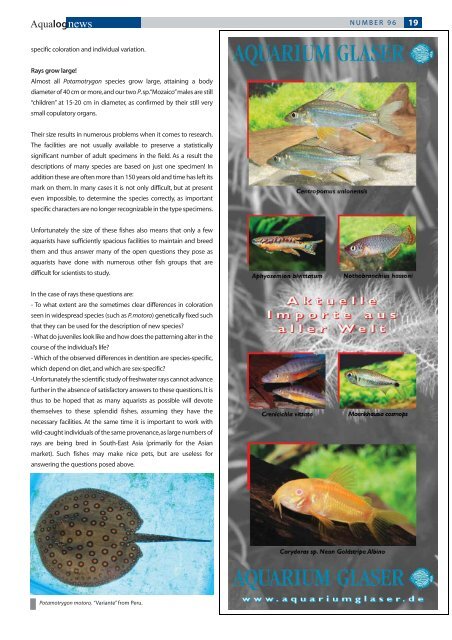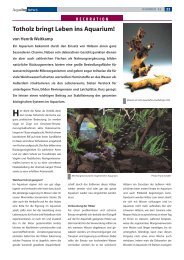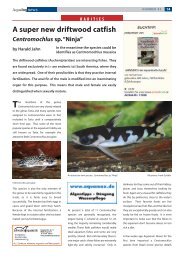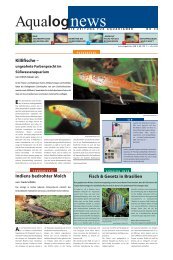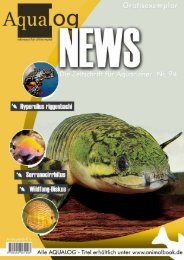Moenkhausia cosmops - Aqualog
Moenkhausia cosmops - Aqualog
Moenkhausia cosmops - Aqualog
Create successful ePaper yourself
Turn your PDF publications into a flip-book with our unique Google optimized e-Paper software.
<strong>Aqualog</strong>news NUMBER 96 19<br />
specific coloration and individual variation.<br />
Rays grow large!<br />
Almost all Potamotrygon species grow large, attaining a body<br />
diameter of 40 cm or more,and our two P.sp.“Mozaico”males are still<br />
“children” at 15-20 cm in diameter, as confirmed by their still very<br />
small copulatory organs.<br />
Their size results in numerous problems when it comes to research.<br />
The facilities are not usually available to preserve a statistically<br />
significant number of adult specimens in the field. As a result the<br />
descriptions of many species are based on just one specimen! In<br />
addition these are often more than 150 years old and time has left its<br />
mark on them. In many cases it is not only difficult, but at present<br />
even impossible, to determine the species correctly, as important<br />
specific characters are no longer recognizable in the type specimens.<br />
Unfortunately the size of these fishes also means that only a few<br />
aquarists have sufficiently spacious facilities to maintain and breed<br />
them and thus answer many of the open questions they pose as<br />
aquarists have done with numerous other fish groups that are<br />
difficult for scientists to study.<br />
In the case of rays these questions are:<br />
- To what extent are the sometimes clear differences in coloration<br />
seen in widespread species (such as P. motoro) genetically fixed such<br />
that they can be used for the description of new species?<br />
- What do juveniles look like and how does the patterning alter in the<br />
course of the individual’s life?<br />
- Which of the observed differences in dentition are species-specific,<br />
which depend on diet, and which are sex-specific?<br />
-Unfortunately the scientific study of freshwater rays cannot advance<br />
further in the absence of satisfactory answers to these questions.It is<br />
thus to be hoped that as many aquarists as possible will devote<br />
themselves to these splendid fishes, assuming they have the<br />
necessary facilities. At the same time it is important to work with<br />
wild-caught individuals of the same provenance,as large numbers of<br />
rays are being bred in South-East Asia (primarily for the Asian<br />
market). Such fishes may make nice pets, but are useless for<br />
answering the questions posed above.<br />
Potamotrygon motoro, “Variante”from Peru.


